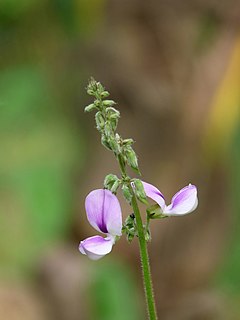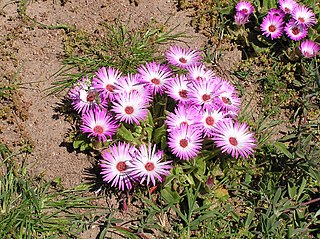Genus is a taxonomic rank used in the biological classification of living and fossil organisms as well as viruses, in biology. In the hierarchy of biological classification, genus comes above species and below family. In binomial nomenclature, the genus name forms the first part of the binomial species name for each species within the genus.

Elaeis is a genus of palms containing two species, called oil palms. They are used in commercial agriculture in the production of palm oil. The African oil palm Elaeis guineensis is the principal source of palm oil. It is native to west and southwest Africa, occurring between Angola and Gambia. The American oil palm Elaeis oleifera is native to tropical Central and South America, and is used locally for oil production.

Asarum is a genus of plants in the birthwort family Aristolochiaceae, commonly known as wild ginger.

Actaea, commonly called baneberry, bugbane and cohosh, is a genus of flowering plants of the family Ranunculaceae, native to subtropical, temperate and subarctic regions of Europe, Asia and North America.

Pueraria is a genus of 15–20 species of plants native to Asia.

Schefflera is a genus of flowering plants in the family Araliaceae. With an estimated 600–900 species, the genus represents about half of its family. The plants are trees, shrubs or lianas, growing 4–20 metres (13–66 ft) tall, with woody stems, the absence of articulated pedicels and armaments, and palmately compound leaves.

Ancistrocladus is a genus of woody lianas in the monotypic family Ancistrocladaceae. The branches climb by twining other stems or by scrambling with hooked tips. They are found in the tropics of the Old World.
The Botanical and Zoological Codes of nomenclature treat the concept of synonymy differently. In botanical nomenclature, a synonym is a scientific name that applies to a taxon that (now) goes by a different scientific name. For example, Linnaeus was the first to give a scientific name to the Norway spruce, which he called Pinus abies. This name is no longer in use: it is now a synonym of the current scientific name, Picea abies. In zoology, moving a species from one genus to another results in a different binomen, but the name is considered an alternative combination, rather than a synonym. The concept of synonymy in zoology is reserved for two names at the same rank that refer to a taxon at that rank - for example, the name Papilio prorsaLinnaeus, 1758 is a junior synonym of Papilio levanaLinnaeus, 1758, being names for different seasonal forms of the species now referred to as Araschnia levana(Linnaeus, 1758), the map butterfly. However, Araschnia levana is not a synonym of Papilio levana in the taxonomic sense employed by the Zoological code.
Bactris jamaicana is a spiny palm which grows in multi-stemmed clumps. It is endemic to Jamaica.
Wilhelm Gerhard Walpers was a German botanist. This botanist is denoted by the author abbreviation Walp. when citing a botanical name.

Ganoderma orbiforme is a species of polypore fungus that is widespread across southeast Asia. It is a plant pathogen that causes basal stem rot, a disease of the African oil palm. The fungus was first described scientifically in 1838 by Elias Magnus Fries from collections made in Guinea. Leif Ryvarden transferred it to the genus Ganoderma in 2000. In addition to its type locality, the fungus has also been collected from the Bonin Islands in the Pacific, and from Venezuela and Puerto Rico. Microsatellite markers have been developed to help identify the fungus and study the genetic diversity of G. orbiforme.

Stylosanthes is a genus of flowering plants in the legume family, Fabaceae and contains numerous highly important pasture and forage species. It was recently assigned to the informal monophyletic Pterocarpus clade of the Dalbergieae. The common name pencilflower is sometimes used for plants in this genus.
Heteranthoecia is a genus of African plants in the grass family. The only known species is Heteranthoecia guineensis, which is widespread across much of tropical Africa from Senegal to Tanzania and Angola.
Cinguloterebra is a genus of sea snails, marine gastropod mollusks in the family Terebridae, the auger snails.

The Genus Utricularia: A Taxonomic Monograph is a monograph by Peter Taylor on the carnivorous plant genus Utricularia, the bladderworts. It was published in 1989 by Her Majesty's Stationery Office (HMSO) as the fourteenth entry in the Kew Bulletin Additional Series. It was reprinted for The Royal Botanic Gardens, Kew in 1994.

Ficus sur, with the common names Cape fig and broom cluster fig, is a widespread Afrotropical species of cauliflorous fig.
The Shorttail snake eel is an eel in the family Ophichthidae. It was described by Balthazar Osório in 1893, originally under the genus Ophichthys. It is a marine, tropical eel which is known from the western and eastern Atlantic Ocean, including Florida, USA, Puerto Rico, Venezuela, the Bahamas, St. Barthelemy, Senegal, Lesser Antilles, and Cape Verde. It dwells at a depth range of 4 to 35 metres, and inhabits the continental shelf, where it forms burrows in sand and mud. Males can reach a maximum total length of 108 centimetres (43 in).
Xyrias guineensis is an eel in the family Ophichthidae. It was described by Jacques Blache in 1975, originally under the genus Ophisurus. It is a marine, deep water-dwelling eel which is known from Pointe Noire, Congo, in the eastern Atlantic Ocean. It is known to dwell at a depth of 300 metres (980 ft), and inhabits burrows formed in sand and mud sediments on the continental shelf. Males can reach a maximum total length of 63.6 centimetres (25.0 in).

Cleretum is a genus of flowering plants in the family Aizoaceae, native to the Cape Provinces of South Africa.










